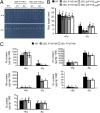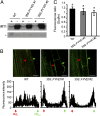Polarization of IRON-REGULATED TRANSPORTER 1 (IRT1) to the plant-soil interface plays crucial role in metal homeostasis
- PMID: 24843126
- PMCID: PMC4050562
- DOI: 10.1073/pnas.1402262111
Polarization of IRON-REGULATED TRANSPORTER 1 (IRT1) to the plant-soil interface plays crucial role in metal homeostasis
Abstract
In plants, the controlled absorption of soil nutrients by root epidermal cells is critical for growth and development. IRON-REGULATED TRANSPORTER 1 (IRT1) is the main root transporter taking up iron from the soil and is also the main entry route in plants for potentially toxic metals such as manganese, zinc, cobalt, and cadmium. Previous work demonstrated that the IRT1 protein localizes to early endosomes/trans-Golgi network (EE/TGN) and is constitutively endocytosed through a monoubiquitin- and clathrin-dependent mechanism. Here, we show that the availability of secondary non-iron metal substrates of IRT1 (Zn, Mn, and Co) controls the localization of IRT1 between the outer polar domain of the plasma membrane and EE/TGN in root epidermal cells. We also identify FYVE1, a phosphatidylinositol-3-phosphate-binding protein recruited to late endosomes, as an important regulator of IRT1-dependent metal transport and metal homeostasis in plants. FYVE1 controls IRT1 recycling to the plasma membrane and impacts the polar delivery of this transporter to the outer plasma membrane domain. This work establishes a functional link between the dynamics and the lateral polarity of IRT1 and the transport of its substrates, and identifies a molecular mechanism driving polar localization of a cell surface protein in plants.
Keywords: Arabidopsis; PI3P; endocytosis; nutrition; radial transport.
Conflict of interest statement
The authors declare no conflict of interest.
Figures




References
-
- Kobayashi T, Nishizawa NK. Iron uptake, translocation, and regulation in higher plants. Annu Rev Plant Biol. 2012;63:131–152. - PubMed
-
- Thomine S, Vert G. Iron transport in plants: Better be safe than sorry! Curr Opin Plant Biol. 2013;16(3):322–327. - PubMed
-
- Korshunova YO, Eide D, Clark WG, Guerinot ML, Pakrasi HB. The IRT1 protein from Arabidopsis thaliana is a metal transporter with a broad substrate range. Plant Mol Biol. 1999;40(1):37–44. - PubMed
Publication types
MeSH terms
Substances
Grants and funding
LinkOut - more resources
Full Text Sources
Other Literature Sources
Medical
Molecular Biology Databases
Research Materials
Miscellaneous

